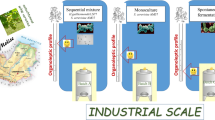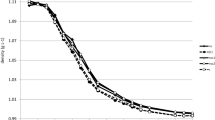Abstract
In this work we evaluate the implantation capacity of the selected S. cerevisiae indigenous strain MMf9 and the quality of the produced wines in a traditional (T) and a modern (M) cellar with different ecological and technological characteristics in North Patagonia (Argentina). Red musts were fermented in 10,000 l vats using the indigenous strain MMf9 as well as the respective controls: a fermentation conducted with a foreign starter culture (BC strain) in M cellar and a natural fermentation in T cellar. Since commercial S. cerevisiae starters are always used for winemaking in M cellar and in order to compare the results, natural fermentations and fermentations conducted by the indigenous strain MMf9 were performed at pilot (200 l) scale in this cellar, concomitantly. Thirty indigenous yeasts were isolated at three stages of fermentation: initial, middle and end. The identification of the yeast biota associated to vinifications was carried out using ITS1-5.8S-ITS2 PCR-RFLP. The intra-specific variability of the S. cerevisiae populations was evaluated using mtDNA-RFLP analysis. Wines obtained from all fermentations were evaluated for their chemical and volatile composition and for their sensory characteristics. A higher capacity of implantation of the indigenous MMf9 strain was evidenced in the fermentation carried out in M cellar (80% at end stage) than the one carried out in T cellar (40%). This behaviour could indicate that each cellar differs in the diversity of S. cerevisiae strains associated to wine fermentations. Moreover a higher capacity of implantation of the native starter MMf9 with regard to the foreign (BC) one was also found in M cellar. The selected indigenous strain MMf9 was able to compete with the yeast biota naturally present in the must. Additionally, a higher rate of sugar consumption and a lower fermentation temperature were observed in vinifications conducted by MMf9 strain with regard to control fermentations, producing wines with favourable characteristics. Even when its implantation in T fermentation was lower than that observed in M one, we can conclude that the wine features from MMf9 fermentations were better than those from their respective controls. Therefore, MMf9 selected indigenous strain could be an interesting yeast starter culture in North Patagonian wines.




Similar content being viewed by others
References
Barata A, Nobre A, Correia P, Malfeito-Ferreira M, Loureiro V (2006) Growth and 4-ethylphenol production by the yeast Pichia guilliermondii in grape juices. Am J Enol Vitic 57:133–138
Bisson LF (1999) Stuck and sluggish fermentation. Am J Enol Vitic 50:107–119
Cocolin L, Bisson LF, Mills DA (2000) Direct profiling of the yeast dynamics in wine fermentations. FEMS Microbiol Lett 189:81–87
Constantí M, Reguant C, Poblet M, Zamora F, Mas A (1998) Molecular análisis of yeast population dynamics: Effect of sulphur dioxide and inoculum on must fermentation. Int J Food Microbiol 41:169–175
Delteil D, Aizac T (1989) Comparison of yeast inoculation techniques by use of a “marked” yeast strain. Aust NZ Wine Indust J 3:53–56
du Toit M, Pretorius IS (2000) Microbial spoilage and preservation of wine: using weapons from nature’s own arsenal. A review. S Afr J Enol Vitic 21:74–96
Epifanio SI, Gutiérrez AR, Santamaría MP, López R (1999) The influence of enological practices on the selection of wild yeast strains in spontaneous fermentation. Am J Enol Vitic 50:219–224
Esteve-Zarzoso B, Belloch C, Uruburu F, Querol A (1999) Identification of yeasts by RFLP analysis of the 5.8S rRNA gene and two ribosomal internal transcribed spacers. Int J Syst Bacteriol 49:329–337
Girard B, Cop TG, Reynolds AG, Cliff M (1997) Influence of vinification treatments on aroma constituents and sensory descriptors of Pinot noir wines. Am J Enol Vitic 48:198–206
Heard GM, Fleet GH (1985) Growth of natural yeast flora during the fermentation of inoculated wines. Appl Environ Microbiol 50:727–728
Jaime E (2003) Clasificación de los aromas de los vinos. El Vino y su Industria 2:44–52
Loiseau G, Vezinhet F, Valade M, Vertes A, Cuinier C, Delteil D (1987) Controle d’ efficacite de levurage por la mise en ovure de souches de levures oenologique marquées. Revue Francaise d’ Oenologie 106:29–36
Lopes CA (2004) Biotecnología de vinos: selección de una cepa de levadura indígena destinada a la producción de un starter de fermentación vínica para ser usado en denominación de origen. PhD Thesis, Universidad Nacional del Comahue
Lopes CA, van Broock M, Querol A, Caballero AC (2002) Saccharomyces cerevisiae wine yeast populations in a cold region in Argentinean Patagonia. A study at different fermentation scales. J Appl Microbiol 93:608–615
Lopes CA, Lavalle TL, Querol A, Caballero AC (2006) Combined use of killer biotype and mtDNA-RFLP patterns in a Patagonian wine Saccharomyces cerevisiae diversity study. Antonie Leeuwenhoek 89:147–156
Martínez J, Millan C, Ortega JM (1989) Growth of natural flora during the fermentation of inoculated musts from “Pedro Ximénez” grapes. S Afr J Enol Vitic 10:31–35
Martorell P, Barata A, Malfeito-Ferreira M, Fernández-Espinar MT, Loureiro V, Querol A (2006) Molecular typing of the yeast species Dekkera bruxellensis and Pichia guilliermondii recovered from wine related sources. Int J Food Microbiol 106:79–84
Mora J, Mulet A (1991) Effects of some treatments of grapes juice on the population and growth of yeast species during fermentation. Am J Enol Vitic 42:133–136
Plata C, Millán C, Mauricio JC, Ortega JM (2003) Formation of ethyl acetate and isoamyl acetate by various species of wine yeasts. Food Microbiol 20:217–224
Pretorius IS, Høj PB (2005) Grape and wine biotechnology: challenges, opportunities and potential benefits. Aust J Grape Wine Res 11:83–108
Querol A, Huerta T, Barrio E, Ramón D (1992) Dry yeast strain for use in fermentation of Alicante wines: selection and DNA patterns. J Food Sci 57:183–185
Ribereau-Gayon P, Dubourdieu D, Doneche B, Lonvaud A (2003) Tratado de Enología 1, Microbiología del vino. Ediciones Hemisferio Sur, Buenos Aires, Argentina
Rohlf FJ (2000) NTSYS-PC: numerical taxonomy and multivariate analysis system, version 2.1. Exeter Software: Setauket, New York
Rojas V, Gil JV, Piñaga F, Manzanares P (2001) Studies on acetate ester production by non-Saccharomyces wine yeasts. Int J Food Microbiol 70:283–289
Romano P, Fiore C, Paraggio M, Caruso M, Capece A (2003) Function of yeast species and strains in wine flavor. Int J Food Microbiol 86:169–180
Romano P, Suzzi G (1993) Sulfur dioxide and wine microorganisms. In: Fleet G (ed) Wine microbiology and biotechnology. Harwood Academic Publishers, Suitzerland, pp 373–394
Sangorrín M, Zajonskovsky I, van Broock M, Caballero A (2002) The use of killer biotyping in an ecological survey of yeast in an old patagonian winery. World J Microbiol Biotechnol 18:115–120
Santamaria P, Garijo P, Lopez R, Tenorio C, Gutierrez AR (2005) Analysis of yeast population during spontaneous fermentation: effect of the age of the cellar and the practice of inoculation. Int J Food Microbiol 103:49–56
Tominaga T, Dubourdieu D (2000) Identification of cysteinylated aroma precursors of certain volatile thiols in passion fruit juice. J Agric Food Chem 48:2874–2876
Tominaga T, Peyrot des Gachons C, Dubourdieu D (1998) A new type of flavor precursors in Vitis vinifera L. cv. Sauvignon blanc:S–cysteine conjugates. J Agric Food Chem 46:5215–5219
Versavaud A, Courcoux P, Roulland C, Dulau L, Hallet J (1995) Genetic diversity and geographical distribution of wild Saccharomyces cerevisiae strains from wine-producing area of Chanrentes, France. Appl Environ Microbiol 61:3521–3529
Acknowledgments
This work was supported by Universidad Nacional del Comahue project I-117 and CONICET post-doc fellowship of C. Lopes. The authors wish to thank S. Genovés for help in IATA and C. Catania (INTA, Lujan de Cuyo, Mendoza, Argentina) for sensory analysis as well as to Valencia University and CSIC for permission to consult www.yeast-id.com database.
Author information
Authors and Affiliations
Corresponding author
Rights and permissions
About this article
Cite this article
Lopes, C.A., Rodríguez, M.E., Sangorrín, M. et al. Patagonian wines: implantation of an indigenous strain of Saccharomyces cerevisiae in fermentations conducted in traditional and modern cellars. J Ind Microbiol Biotechnol 34, 139–149 (2007). https://doi.org/10.1007/s10295-006-0178-0
Received:
Accepted:
Published:
Issue Date:
DOI: https://doi.org/10.1007/s10295-006-0178-0




